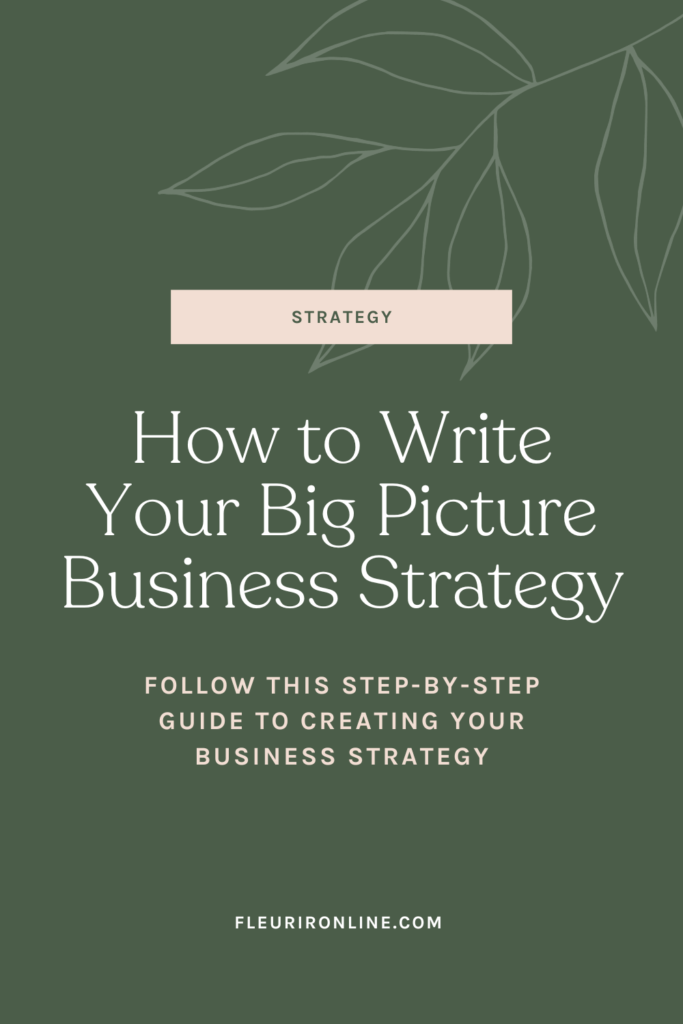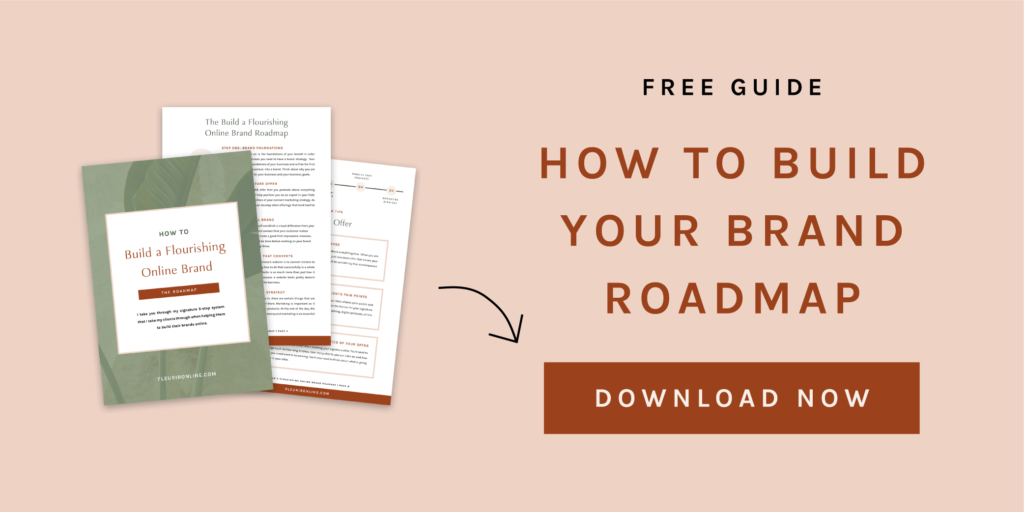I have always been a huge advocate of strategy in business and I strongly believe that it’s not possible to build a long-term sustainable business without one. In this blog post, you’ll learn how to write your business strategy.
When first starting out in business, a detailed strategy isn’t necessarily needed. However, after you’ve spent a year or two experimenting with what works, what doesn’t work, what you enjoy and what you don’t enjoy, it’s then time to start thinking about the future of the business and that’s where strategy comes in.
Creating a business strategy for your business doesn’t need to be overwhelming and I’m going to show you that in this episode.
The idea behind an overall strategy for the year is that you don’t want to go into too much detail and that’s what stops it from feeling overwhelming. Mapping out your strategy should be exciting and help you see the potential in your business.
If you’re listening to this whilst on a walk or in the car, I’d definitely recommend coming back to it later when you’re somewhere where you can sit down with a pen and paper or have a Google Doc open so you can work through each of the steps and pause it as necessary.
Let’s get started, shall we…

Listen to this episode
Listen to this episode and subscribe using your favourite podcast app!
Apple Podcasts | Spotify
Step 1 – Audit the previous year
The first step to creating your very own big-picture business strategy is to audit the previous year.
Although auditing may not sound very exciting, it’s essential to review what did and didn’t go well in the previous year in order to learn from your findings and to use those learnings going into a new year.
Your audit should cover everything from your goals, finances, offerings and marketing. With this in mind, some questions you may want to ask yourself when conducting your audit are:
- What did you achieve this year that you are really proud of?
- What products and/or services bought you the most revenue this year?
- Who did you really enjoy working with this year?
- What did you love most about your business this year?
- What marketing efforts worked really well this year?
- What didn’t work so well this year?
Step 2 – Think about your big-picture vision
Now you’ve reviewed what did and didn’t go well last year, it’s time to start thinking about your big-picture vision.
First of all, I want you to write down what your overall vision is for your business. For this think as far ahead as you can manage. For some people that might mean that you can think 12 months ahead. Others may be able to picture what they want for their business in 3 or 5 years’ time.
It’s important to allow yourself to think as big as possible here. This is not the time to play small. If you are currently a solo business owner and you have the vision to grow your business into one with a team, then write this down, even if it feels unrealistic right now. Perhaps you are currently only offering 1:1 services and you want to replace 50% of your income with digital offerings. Put that down on paper!
The next part of your big-picture vision is to think about what success looks like to you. It’s a noisy world out there and I think sometimes our own versions of success can get muddled up with what we think we should be doing based on what we have seen others do. Success looks different for everyone and it’s really important that you are building a life and business based on your own version.
For example, a couple of years ago everyone wanted to work towards a £100k year. Then once more and more people started making that £100k year, the next step seemed to be seven figures and now multi-seven figures.
I will tell you now that my goal for my business this year is to make £250,000 in sales. Once I hit that £250k in sales, I will be more than happy if I manage to sustain that figure. I also have no desire to build a large team. I would absolutely love to be able to bring on one full-time team member in my business and that’s part of my longer-term vision. I’m also happy if I only have a couple of core contractors as part of my team too. Something else that’s really important to me is keeping my profits high so that the business is retaining most of the revenue that comes in. It’s all well and good having a business that brings in a million pounds a year but if only 20-30% of that is profit, the profit is not too dissimilar from my simple business model with a quarter of a million pounds in revenue.
Does this mean I’m not dreaming big enough? No, not at all! It just means that right now I have no desire to build a 7-figure or multi-7-figure business. Might that change in the future? Quite possibly but for right now where I am, I’m happy with my goal of a quarter of a million. I’m happy with my plans of keeping things as simple and low-stress as possible.
Because I’m clear on my goals, it means when I’m planning out the strategy for my business, I know where I want to be putting my efforts and I’ll be talking more about my plans for the business in the next episode so keep an eye out for that.
Step 3 – Map out your personal and revenue goals for this year
Now it’s time to start getting down to the finer details and we are going to start with goals.
There are mixed opinions around goal setting and those opinions start to get even louder at the beginning of the year when goal setting and resolutions become more prominent.
I personally really love setting goals. Goals are what help drive me towards my vision and keep me motivated however goals are only useful if you plan how you will make them happen and then actually follow through with the action to make them a reality.
When thinking about your goals and intentions for the year ahead, I recommend that you break them down into personal and revenue for now.
Personal – The very first goals I want you to think about are your personal goals. After all, this business of yours should be aiding you in achieving the personal goals that you have. Perhaps you want to buy a house or a second property. You might want to get married this year or plan for children. How much do you want to put away in savings or put toward existing debts? What holidays do you want to take? Perhaps you want to invest in personal development this year. Look at how much that will cost and factor that into your goals.
Revenue – What is your overall revenue goal for this year? At this stage, I don’t want you to think too much about how you’re going to achieve that goal but rather what the overall number is for the year. When thinking about your revenue goal, don’t just pick a random number, make it intentional. Think about what you want to achieve this year both professionally and personally and add it all up. For example, in my revenue goal for the year, I have thought about what personal goals we have and what goals I have for the business including my salary and expenses. I then added it all up and added the relevant percentage on top for taxes. This then gave me my overall revenue goal for this year.

Step 4 – Review your products and services
Now you can picture your vision and you know what goals you want to achieve, it’s time to look at reviewing your products and services.
For this part, I want you to take a look at the information you collected during your audit and use this when reviewing your offers for the year.
If you haven’t yet, ask yourself these questions…
- What are your current products and services?
- What products and/or services bought you the most revenue this year?
- Are there any products or services that you would like to launch in the next 12 months?
- Are there any products or services that you no longer want to offer?
This is the perfect time to review the products and services that are and aren’t working in your business. You may also want to look at revising particular offers and making changes to the structure and delivery.
Step 5 – Work out your financial projections/sales
Something that all successful businesses do is plan out financial projections so that they can see where they need to put their efforts. When doing this I want you to be realistic about what you can do. For example, if your overall financial goal is to make £100,000 in sales this year, what products and services will you need to sell in order to achieve this?
This exercise is really useful because if once you have done this, it shows that you need to work with 5 done-for-you clients a month in order to reach your goals but you only have the capacity for 2, you then need to look at what needs to change in order to make it happen. This is usually where you will look at things such as your pricing and your team.
Step 6 – Set marketing goals
Something that we used to do when I worked in corporate was set marketing goals based on our overall business goals. This is something that I don’t often see mentioned as much in the online business space however marketing goals are important because in order to build a sustainable business, we need to be continually growing and nurturing our audience. This is especially the case if you want to expand into digital products and courses or grow this side of the business further.
When thinking about your marketing goals, it’s not simply a case of I want to grow my email list to 10,000 subscribers just because that sounds like a good number. Setting goals around audience growth should always relate back to the financial projections that you set in the previous step. Let’s say you have a goal to sell 100 spots on your course in your launch that you are planning for 6 months time. The average conversion rate is between 1-5% so if we base a conversion rate of 2%, you’ll need an audience of around 5,000 people. This isn’t necessarily set in stone and just because you have 5,000 people on your email list, it doesn’t mean you’ll definitely hit your goal of 100 course sales as there are many more factors that go into it but it’s a good place to start.
Marketing goals also don’t always need to be attributed to audience growth. They can and should also be about increasing the connection with your current audience. For example, you may want to look at increasing your open and click-through rates on your emails or increasing your engagement on social media.
Something that is important to mention here is that whilst numbers are important, it goes without saying that the quality of the people in your audience is even more important.
Step 7 – Operations
We are getting near the end of the big-picture planning and the last topic I want to talk about is operations.
Operations are the backbone of your business so it’s important that we include this as part of your big-picture planning. When I talk about operations, I’m generally talking about your systems, processes and team.
Some questions to think about here are:
- How do you feel about your current systems? Do they meet your current needs?
- Are there any gaps in your systems? Is there anything you need to bring in to meet your goals?
- Do you currently have a team? If yes, what does that look like?
- Do you plan to/need to hire any team members this year? If yes, who?

I hope you have found this episode useful and that it helps you plan your strategy for 2023. Planning a strategy isn’t something that you do at the beginning of the year and then forget about it. It’s important to revisit your strategy regularly throughout the year so that you can assess how things are going and make any changes if needed. Revisiting your strategy is something that I’d recommend doing every 90 days which ties in perfectly with the next episode all about creating your 90-day plan. This allows you to create a detailed plan of action for 90 days in your business and this is what I’m going to cover in next week’s episode so be sure to listen to the next episode for part 2.
Something else I want to mention before we sign out for this episode is that a big-picture strategy is not something that you can only do at the beginning of the year. If you’re listening to this episode or reading this blog post in May for example, you can still plan out your strategy for the remainder of the year or for the next 12 months from when you are listening.



